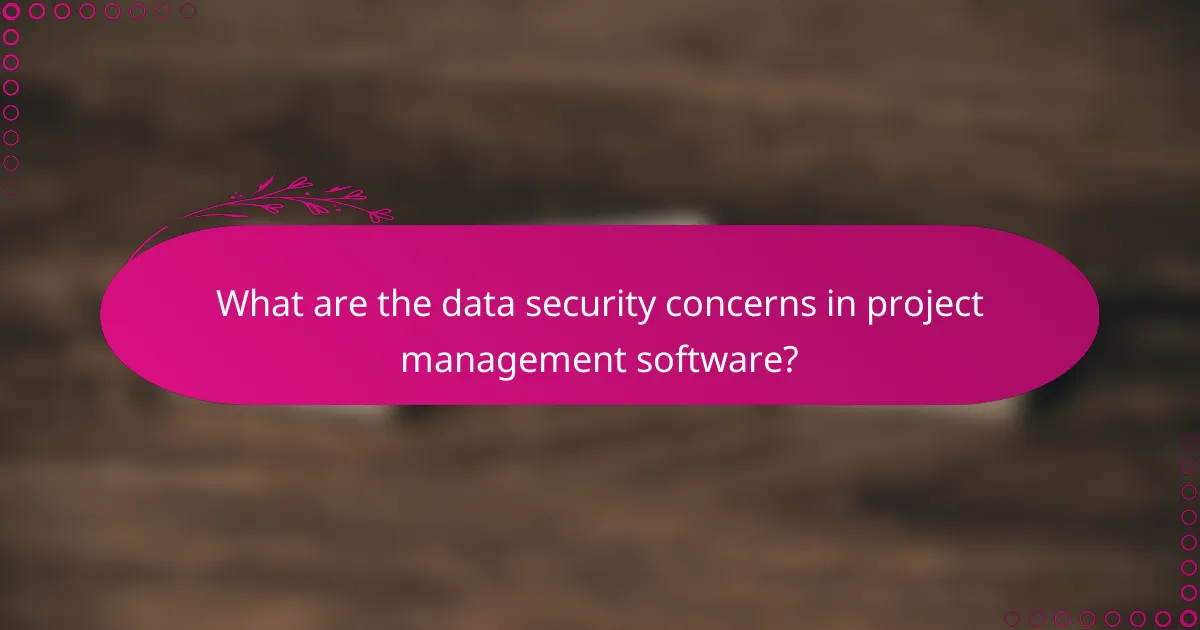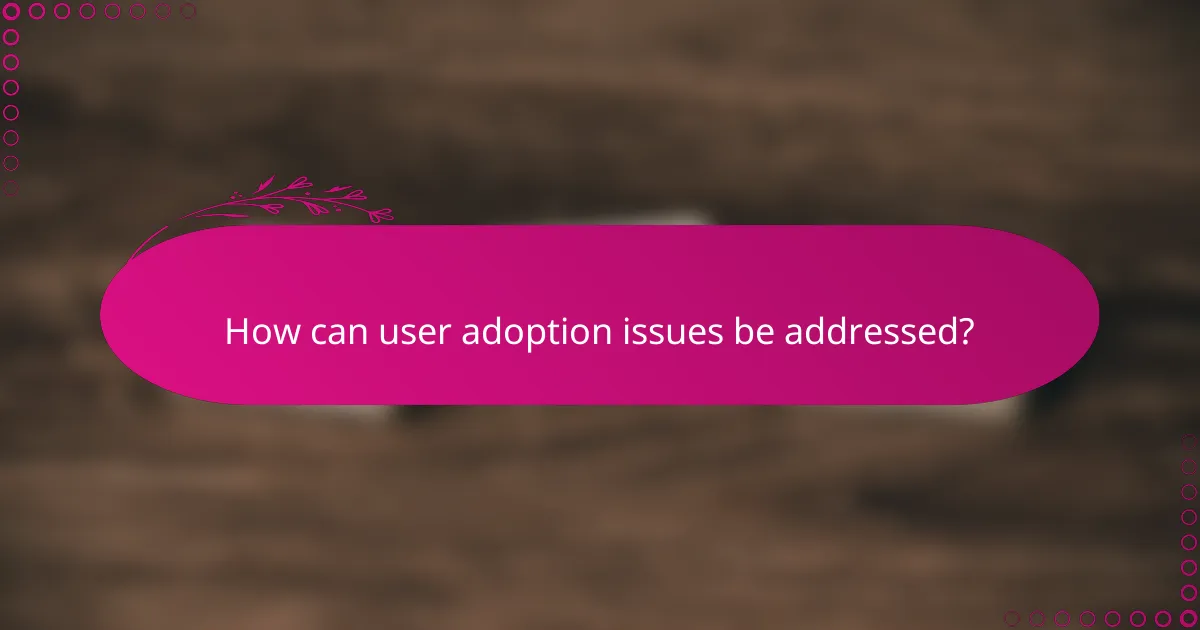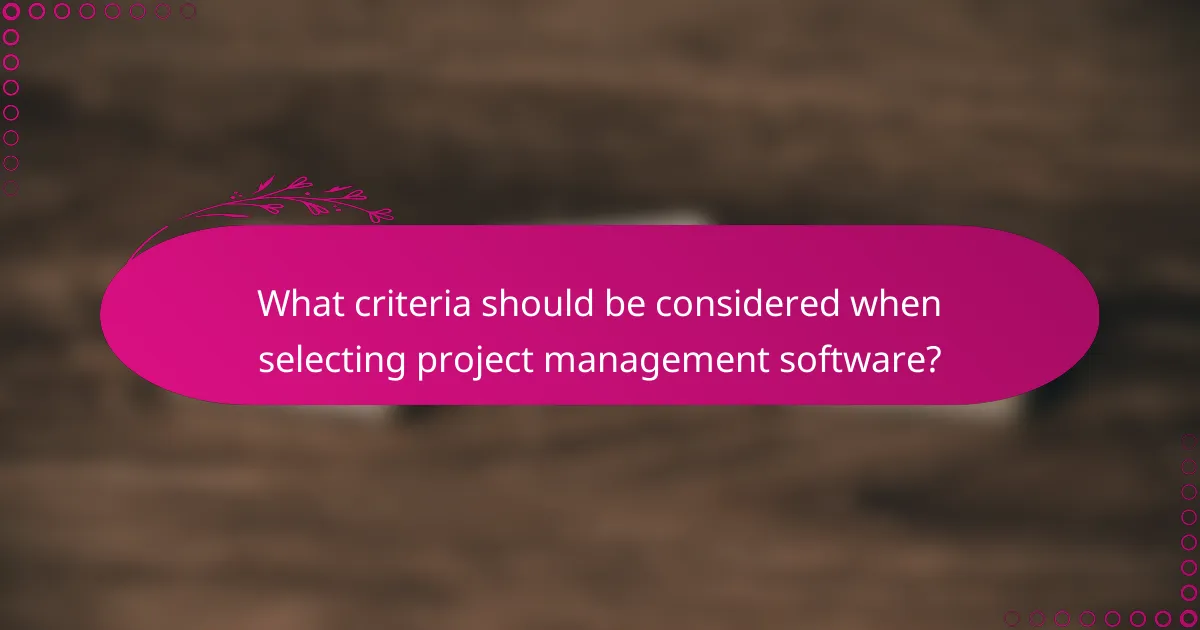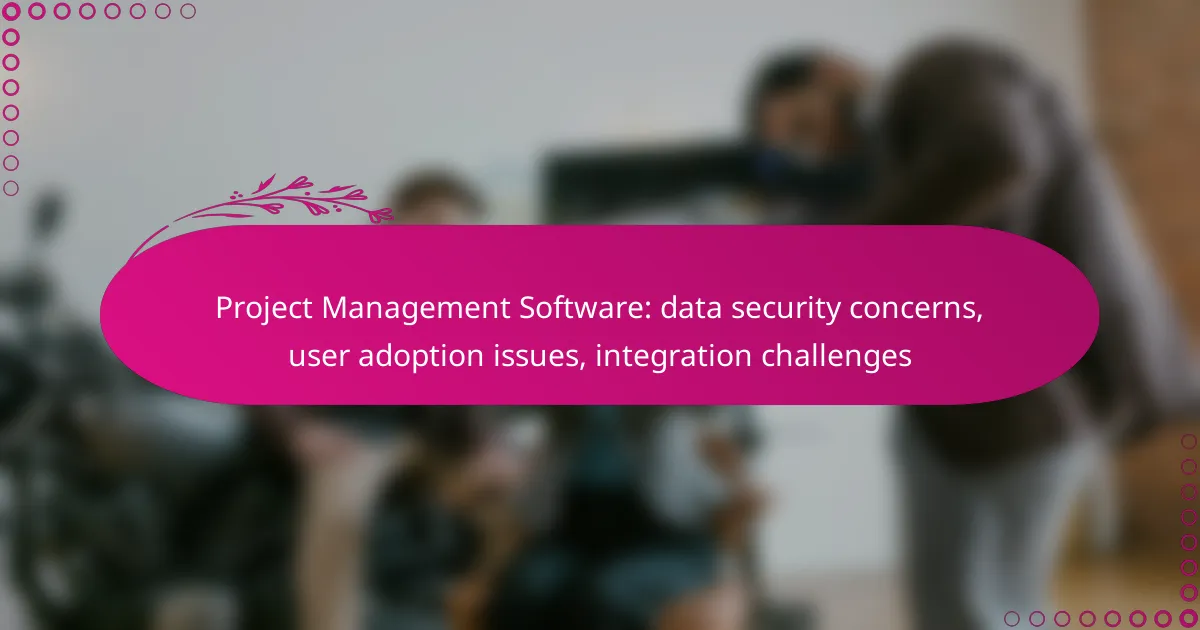Project management software plays a vital role in enhancing team collaboration and productivity, but it also raises significant concerns regarding data security, user adoption, and integration challenges. Protecting sensitive information from unauthorized access is paramount, alongside ensuring users are engaged and comfortable with the software. Additionally, overcoming integration hurdles is essential for achieving seamless workflows and maximizing the software’s potential.

What are the data security concerns in project management software?
Data security concerns in project management software primarily revolve around protecting sensitive information from unauthorized access and breaches. Key issues include data encryption, user access controls, compliance with local regulations, third-party vendor security, and incident response protocols.
Data encryption standards
Data encryption is essential for safeguarding sensitive project information. Strong encryption standards, such as AES-256, should be implemented to protect data at rest and in transit. This ensures that even if data is intercepted, it remains unreadable without the proper decryption keys.
When selecting project management software, verify that it complies with industry encryption standards. Regular updates and security patches are also crucial to maintain robust encryption practices.
User access controls
User access controls help manage who can view and edit project data. Implementing role-based access control (RBAC) allows organizations to assign permissions based on user roles, minimizing the risk of unauthorized access. This ensures that only those who need to see sensitive information can access it.
Regularly review and update user permissions to adapt to changes in team structure or project requirements. This practice helps prevent potential data leaks and maintains data integrity.
Compliance with Australian data protection laws
In Australia, compliance with the Privacy Act and the Australian Privacy Principles (APPs) is critical for project management software. These regulations mandate how personal data should be collected, stored, and used, emphasizing transparency and user consent.
Ensure that the software provider has measures in place to comply with these laws, including data breach notification protocols and user rights to access their data. Regular audits can help maintain compliance and build trust with users.
Third-party vendor security
When using project management software that integrates with third-party vendors, it is vital to assess their security practices. Ensure that these vendors adhere to similar data security standards to mitigate risks associated with data sharing and integration.
Request security assessments and certifications from vendors to verify their commitment to data protection. Establish clear contracts that outline security responsibilities and data handling procedures.
Incident response protocols
Incident response protocols are essential for quickly addressing data breaches or security incidents. A well-defined plan should include steps for identifying, containing, and mitigating breaches, as well as notifying affected parties.
Regularly test and update the incident response plan to ensure its effectiveness. Training staff on their roles during an incident can significantly reduce response times and minimize damage.

How can user adoption issues be addressed?
Addressing user adoption issues involves implementing strategies that enhance engagement and ease of use. Focusing on comprehensive training, user-friendly interfaces, feedback mechanisms, and incentives can significantly improve the likelihood of successful adoption.
Comprehensive training programs
Comprehensive training programs are essential for ensuring users feel confident in utilizing project management software. These programs should cover all features and functionalities, ideally through a mix of live sessions, recorded tutorials, and hands-on practice.
Consider offering training sessions tailored to different user roles, as this can help address specific needs and use cases. Regularly updating training materials to reflect software changes is also crucial for ongoing user support.
User-friendly interfaces
A user-friendly interface is vital for promoting user adoption. Software that is intuitive and easy to navigate reduces the learning curve and encourages users to engage with the platform more frequently.
When selecting project management software, prioritize options with customizable dashboards and clear visual cues. Conduct usability testing with potential users to identify and address any interface issues before full implementation.
Feedback mechanisms for continuous improvement
Implementing feedback mechanisms allows users to share their experiences and suggest improvements. Regular surveys, suggestion boxes, and focus groups can provide valuable insights into user challenges and preferences.
Actively responding to feedback not only helps refine the software but also fosters a sense of community and ownership among users. Consider establishing a dedicated team to monitor feedback and implement changes based on user input.
Incentives for early adopters
Offering incentives for early adopters can motivate users to engage with new software. This could include discounts, exclusive features, or recognition within the organization for those who embrace the new system early on.
Incentives can also be structured around achieving specific milestones, such as completing training or utilizing certain features. This approach not only boosts initial adoption but can also encourage ongoing use and exploration of the software’s capabilities.

What are the integration challenges with project management software?
Integration challenges with project management software often arise from compatibility issues, lack of proper API documentation, and difficulties in data migration. Addressing these challenges is crucial for ensuring seamless workflows and maximizing the software’s effectiveness.
Compatibility with existing tools
Ensuring compatibility with existing tools is a primary challenge when integrating project management software. Organizations often use a variety of applications, and if the new software cannot work with these tools, it can lead to inefficiencies. It’s essential to assess the current tech stack and verify that the new software can connect with key applications like email, calendars, and file storage systems.
To mitigate compatibility issues, consider software that offers pre-built integrations with popular tools or supports common file formats. Conducting a compatibility audit before implementation can save time and resources.
API availability and documentation
The availability of a robust API and comprehensive documentation is vital for successful integration. A well-documented API allows developers to create custom connections between the project management software and other systems. Without clear documentation, teams may struggle to implement necessary integrations, leading to delays and increased costs.
When evaluating project management software, prioritize options that provide extensive API documentation and support. Look for user reviews or case studies that highlight successful integrations to gauge the API’s effectiveness.
Data migration processes
Data migration is often a complex process that can pose significant challenges during integration. Transferring data from legacy systems to new software requires careful planning to avoid data loss or corruption. It’s crucial to establish a clear migration strategy that includes data mapping, cleansing, and validation steps.
Consider using migration tools or services that can automate parts of the process. Testing the migration with a small data set before full implementation can help identify potential issues early on.
Integration support services
Access to integration support services can significantly ease the challenges associated with implementing project management software. Many vendors offer dedicated support teams to assist with integration, troubleshooting, and ongoing maintenance. Utilizing these services can help ensure a smoother transition and faster resolution of any issues that arise.
When selecting project management software, inquire about the availability and quality of integration support services. Look for vendors that provide comprehensive onboarding and ongoing assistance to maximize the software’s potential in your organization.

What criteria should be considered when selecting project management software?
When selecting project management software, it’s essential to consider factors such as scalability, cost-effectiveness, and reporting capabilities. These criteria help ensure that the software meets the current and future needs of your team while providing valuable insights into project performance.
Scalability for team growth
Scalability refers to the software’s ability to accommodate an increasing number of users or projects without compromising performance. As your team grows, the software should seamlessly support additional users and expanded functionalities.
Look for solutions that offer tiered pricing or modular features, allowing you to pay for only what you need initially. This way, you can upgrade as your team expands, avoiding unnecessary costs during early stages.
Cost-effectiveness of subscription plans
Cost-effectiveness is crucial when evaluating subscription plans for project management software. Consider both the upfront costs and any ongoing fees, as well as the value provided by the features included in each plan.
Compare different pricing models, such as monthly versus annual subscriptions, and assess how many users are covered under each plan. Some software may offer discounts for larger teams or longer commitments, which can significantly impact your budget.
Reporting and analytics capabilities
Robust reporting and analytics capabilities are vital for tracking project progress and team performance. Look for software that provides customizable reports, real-time dashboards, and key performance indicators (KPIs) relevant to your projects.
Effective reporting tools can help identify bottlenecks and areas for improvement. Ensure the software allows for easy data export and integration with other analytics tools you may already use, enhancing your overall project management strategy.
